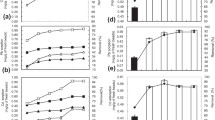Summary
Spores of Fusarium flocciferum were inserted in porous celite beads. The effects of bead size, adsorption time course, washing cycle and spore concentration on spore loading were investigated. Cell loadings up to 50% (dry weight/beads) were obtained. The degradation of phenol using adsorbed cells was studied in batch experiments. The immobilized cell system was shown to efficiently degrade high concentrations of the substrate (up to 2.0 g/l) and to remain active for more than 2 motths. The oxygen uptake rate of free and immobilized cells was determined at various concentrations of phenol. The kinetic constants K s=85 mg/l, K i=345 mg/l and SMI=170 mg/l were estimated from the experimental data by linearization of the Haldane function for the free cells. The uptake rates exhibited by the confined cells were lower (30%) than those obtained for free cells and no significant differences were found for phenol concentrations between 150 and 1200 mg/l.
Similar content being viewed by others
References
Anselmo AM, Novais JM (1984) Isolation and selection of phenol-degrading microorganisms from an industrial effluent. Biotechnol Lett 6:601–606
Anselmo AM, Mateus M, Cabral JMS, Novais JM (1985) Degradation of phenol by immobilized cells of Fusarium flocciferum. Biotechnol Lett 7:889–894
Bettmann H, Rehm HJ (1984) Degradation of phenol by polymer entrapped microorganisms. Appl Microbiol Biotechnol 20:285–290
Ehrhardt HM, Rehm HJ (1985) Phenol degradation by microorganisms adsorbed on activated carbon. Appl Microbiol Biotechnol 21:32–36
Gbewonyo K, Wang DIC (1983a) Confining mycelial growth to porous microbeads: a novel technique to alter morphology of non-newtonian mycelial cultures. Biotechnol Bioeng 25:967–983
Gbewonyo K, Wang DIC (1983b) Enhancing gas-liquid mass transfer rates in non-newtonian fermentation by confining mycelial growth to microbeads in a bubble column. Biotechnol Bioeng 25:2873–2887
Hill GA, Robinson CW (1975) Substrate inhibition kinetics: phenol degradation by P. putida. Biotechnol Bioeng 27:1599–1615
Klein J, Hackel U, Wagner F (1979) Phenol degradation by Candida tropicalis whole cells entrapped in polymeric ionic networkd. ACS Symp Ser 106:101–118
Luong JHT (1987) Generalization of Monod kinetics for analysis of growth data with substrate inhibition. Biotechnol Bioeng 24:242–248
Meyrath J, Suchanek G (1972) Inoculation techniques-effects due to quality and quantity of inoculum. In: Norris JR, Ribbons DW (eds) Methods in Microbiology, vol 7B. Academic Press, London, pp 184–185
Pawloswsky U, Howell JA (1973) Mixed culture biooxidation of phenol. I. Determination of kinetic parameters. Biotechnol Bioeng 15:889–896
Umbreit WW, Burris RH, Stauffer JF (1964) Manometric techniques, 3rd edn. Burgess Publishing, Minneapolis
Author information
Authors and Affiliations
Rights and permissions
About this article
Cite this article
Anselmo, A.M., Cabral, J.M.S. & Novais, J.M. The adsorption of Fusarium flocciferum spores on celite particles and their use in the degradation of phenol. Appl Microbiol Biotechnol 31, 200–203 (1989). https://doi.org/10.1007/BF00262463
Received:
Accepted:
Issue Date:
DOI: https://doi.org/10.1007/BF00262463




